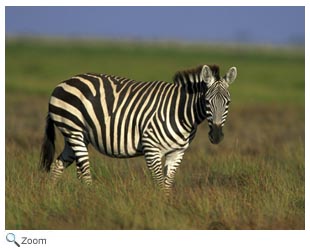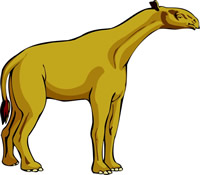Perissodactyla - horses, rhinoceroses, tapirs
 There are 16 species of large mammals in this order in three families. The species in this order have an odd number of toes on their feet. In fact, they are sometimes called odd-toed ungulates. There are 16 species of large mammals in this order in three families. The species in this order have an odd number of toes on their feet. In fact, they are sometimes called odd-toed ungulates.
The middle toe of the species in this order is larger than the other toes, and it is the toe that bears the weight of the animal when it walks. Some species, like tapirs and rhinoceroses, have three toes. Other species, like horses, have evolved over time and now only have one toe or hoof!
The species in this order also have long, tapered faces and large nostrils. Members of the rhinoceros family have horns on their faces. The species in this order are herbivores and the browse and graze for their food. Two species in this order, the horse and the donkey, have been domesticated. Members in this order are native species on all continents except for Australia and Antarctica.
 At one time, millions and millions of years ago, there were at least 14 families in this order and many, many more species. They were found all over the world. The largest mammal to ever live, the Indricotherium, was a member of this order. The Indricotherium was 26 feet high at the shoulders and 39 feet long! The Indricotherium was found in Asia. Most of the species in this order began to disappear during the
late Miocene (10-5
million years ago) as animals in the Artiodactyla order grew and began competing with them for food. Today, there are only three families left in this order. At one time, millions and millions of years ago, there were at least 14 families in this order and many, many more species. They were found all over the world. The largest mammal to ever live, the Indricotherium, was a member of this order. The Indricotherium was 26 feet high at the shoulders and 39 feet long! The Indricotherium was found in Asia. Most of the species in this order began to disappear during the
late Miocene (10-5
million years ago) as animals in the Artiodactyla order grew and began competing with them for food. Today, there are only three families left in this order.
|


 At one time, millions and millions of years ago, there were at least 14 families in this order and many, many more species. They were found all over the world. The largest mammal to ever live, the Indricotherium, was a member of this order. The Indricotherium was 26 feet high at the shoulders and 39 feet long! The Indricotherium was found in Asia. Most of the species in this order began to disappear during the
late Miocene (10-5
million years ago) as animals in the
At one time, millions and millions of years ago, there were at least 14 families in this order and many, many more species. They were found all over the world. The largest mammal to ever live, the Indricotherium, was a member of this order. The Indricotherium was 26 feet high at the shoulders and 39 feet long! The Indricotherium was found in Asia. Most of the species in this order began to disappear during the
late Miocene (10-5
million years ago) as animals in the